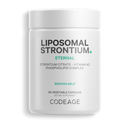- El suplemento Codeage Estroncio Liposomal contiene estroncio, procedente del citrato de estroncio, una forma reconocida por su biodisponibilidad para ayudar a promover la salud ósea.*
- Cada cápsula de estroncio está enriquecida con vitamina K2 en forma MK-7, un nutriente esencial que puede desempeñar un papel en la mineralización ósea y la salud cardiovascular.*
- Este suplemento de estroncio liposomal también presenta una administración liposomal que comprende aceite de girasol sin OGM y lecitina para ayudar a la administración y biodisponibilidad de sus ingredientes.
- Esta fórmula de estroncio no contiene OGM, lácteos, soja ni gluten. Cada botella de Codeage Liposomal Strontium ofrece 30 porciones para 1 mes de suministro.
- El suplemento Codeage Estroncio Liposomal se fabrica en los EE. UU. con ingredientes globales en una instalación certificada por cGMP por su calidad y pureza.
Liposomal Strontium.
Liposomal Strontium.
- El suplemento Codeage Estroncio Liposomal contiene estroncio, procedente del citrato de estroncio, una forma reconocida por su biodisponibilidad para ayudar a promover la salud ósea.*
- Cada cápsula de estroncio está enriquecida con vitamina K2 en forma MK-7, un nutriente esencial que puede desempeñar un papel en la mineralización ósea y la salud cardiovascular.*
- Este suplemento de estroncio liposomal también presenta una administración liposomal que comprende aceite de girasol sin OGM y lecitina para ayudar a la administración y biodisponibilidad de sus ingredientes.
- Esta fórmula de estroncio no contiene OGM, lácteos, soja ni gluten. Cada botella de Codeage Liposomal Strontium ofrece 30 porciones para 1 mes de suministro.
- El suplemento Codeage Estroncio Liposomal se fabrica en los EE. UU. con ingredientes globales en una instalación certificada por cGMP por su calidad y pureza.
Artículo similar a considerar

Liposomal NAD+
$69.99Información nutricional

Ingredientes
Estroncio (de 2,2 g de citrato de estroncio), vitamina K2 (como MK-7). Otros ingredientes: Cápsula de metilcelulosa, celulosa microcristalina, aceite de girasol sin OGM y lecitina (que contiene fosfatidilcolina; matriz de administración liposomal).
Artículo similar a considerar

Liposomal NAD+
$69.99EXPLORA MÁS.
PRODUCTO GALERÍA.





Product Details
Supplement Facts

Ingredients
Estroncio (de 2,2 g de citrato de estroncio), vitamina K2 (como MK-7). Otros ingredientes: Cápsula de metilcelulosa, celulosa microcristalina, aceite de girasol sin OGM y lecitina (que contiene fosfatidilcolina; matriz de administración liposomal).
Suggested Use
Los adultos toman 3 cápsulas al día, o según lo recomiende su médico, con 8 onzas de agua o su bebida favorita. Puede tomarse con o sin alimentos. Para una mejor absorción, tome estroncio con al menos dos horas de diferencia con el calcio.
PRECAUCIÓN: No exceda la dosis recomendada. Las mujeres embarazadas, las madres lactantes, los niños menores de 18 años y las personas con una afección médica conocida deben consultar a un médico antes de usar este o cualquier suplemento dietético. Tenga cuidado si tiene alergias o sensibilidades a alguno de los ingredientes enumerados. Mantener fuera del alcance de los niños y las mascotas. No lo utilice si el sello de seguridad está dañado o falta. Guardar en un lugar fresco y seco. Utilice este producto únicamente como complemento alimenticio. No utilice para la reducción de peso.
EXPLORA MÁS.

Redefiniendo la salud ósea.*
Codeage Liposomal Strontium supplement combines bioavailable Strontium Citrate with Vitamin K2 (MK-7) in a convenient capsule format. Featuring a liposomal delivery system made with non-GMO sunflower oil and lecithin, this elemental strontium formula is non-GMO, dairy-free, soy-free, and gluten-free.
USO SUGERIDO.
Los adultos toman 3 cápsulas al día, o según lo recomiende su médico, con 8 onzas de agua o su bebida favorita. Puede tomarse con o sin alimentos. Para una mejor absorción, tome estroncio con al menos dos horas de diferencia con el calcio.
PRECAUCIÓN: No exceda la dosis recomendada. Las mujeres embarazadas, las madres lactantes, los niños menores de 18 años y las personas con una afección médica conocida deben consultar a un médico antes de usar este o cualquier suplemento dietético. Tenga cuidado si tiene alergias o sensibilidades a alguno de los ingredientes enumerados. Mantener fuera del alcance de los niños y las mascotas. No lo utilice si el sello de seguridad está dañado o falta. Guardar en un lugar fresco y seco. Utilice este producto únicamente como complemento alimenticio. No utilice para la reducción de peso.





































































